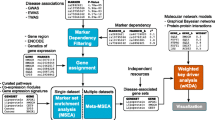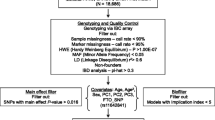Abstract
Putatively functional polymorphisms of one-carbon and xenobiotic metabolic pathways influence susceptibility for wide spectrum of diseases. The current study was aimed to explore gene–gene interactions among these two metabolic pathways in four diseases i.e. breast cancer, systemic lupus erythematosus (SLE), coronary artery disease (CAD) and Parkinson’s disease (PD). Multifactor dimensionality reduction analysis was carried out on four case–control datasets. Cross-talk was observed between one-carbon and xenobiotic pathways in breast cancer (RFC 80 G>A, COMT H108L and TYMS 5′-UTR 28 bp tandem repeat) and SLE (CYP1A1 m1, MTRR 66 A>G and GSTT1). Gene–gene interactions within one-carbon metabolic pathway were observed in CAD (GCPII 1561 C>T, SHMT 1420 C>T and MTHFR 677 C>T) and PD (cSHMT 1420 C>T, MTRR 66 A>G and RFC1 80 G>A). These interaction models showed good predictability of risk for PD (The area under the receiver operating characteristic curve (C) = 0.83) and SLE (C = 0.73); and moderate predictability of risk for breast cancer (C = 0.64) and CAD (C = 0.63). Cross-talk between one-carbon and xenobiotic pathways was observed in diseases with female preponderance. Gene–gene interactions within one-carbon metabolic pathway were observed in diseases with male preponderance.






Similar content being viewed by others
Abbreviations
- GCPII:
-
Glutamate carboxypeptidase II
- RFC1:
-
Reduced folate carrier1
- cSHMT:
-
Cytosolic serine hydroxy methyltransferase
- TYMS:
-
Thymidylate synthase
- MTHFR:
-
Methylene tetrahydrofolate reductase
- MTR:
-
5-Methyltetrahydrofolate-homocysteine methyltransferase
- MTRR:
-
5-Methyltetrahydrofolate-homocysteine methyltransferase reductase
- SAM:
-
S-adenosyl methionine
- SAH:
-
S-adenosyl homocysteiene
- CYP1A1:
-
Cytochrome P450
- GST:
-
Glutathione-S-transferase
- COMT:
-
Catecholamine-O-methyl transferase
- MDR:
-
Multifactor dimensionality reduction analysis
- SLE:
-
Systemic lupus erythematosus
- CAD:
-
Coronary artery disease
- PD:
-
Parkinson’s disease
References
Suzuki T, Matsuo K, Hirose K, Hiraki A, Kawase T, Watanabe M, Yamashita T, Iwata H, Tajima K (2008) One-carbon metabolism-related gene polymorphisms and risk of breast cancer. Carcinogenesis 29(2):356–362
Sergentanis TN, Economopoulos KP (2010) Four polymorphisms in cytochrome P450 1A1 (CYP1A1) gene and breast cancer risk: a meta-analysis. Breast Cancer Res Treat 122(2):459–469
Guéant-Rodriguez RM, Juilliére Y, Candito M, Adjalla CE, Gibelin P, Herbeth B, Van Obberghen E, Gueánt JL (2005) Association of MTRRA66G polymorphism (but not of MTHFR C677T and A1298C, MTRA2756G, TCN C776G) with homocysteine and coronary artery disease in the French population. Thromb Haemost 94(3):510–515
Manfredi S, Federici C, Picano E, Botto N, Rizza A, Andreassi MG (2007) GSTM1, GSTT1 and CYP1A1 detoxification gene polymorphisms and susceptibility to smoking-related coronary artery disease: a case-only study. Mutat Res 621(1–2):106–112
Fong CS, Shyu HY, Shieh JC, Fu YP, Chin TY, Wang HW, Cheng CW (2011) Association of MTHFR, MTR, and MTRR polymorphisms with Parkinson’s disease among ethnic Chinese in Taiwan. Clin Chim Acta 412(3–4):332–338
Singh M, Khan AJ, Shah PP, Shukla R, Khanna VK, Parmar D (2008) Polymorphism in environment responsive genes and association with Parkinson disease. Mol Cell Biochem 312(1–2):131–138
Burzynski M, Duriagin S, Mostowska M, Wudarski M, Chwalinska-Sadowska H, Jagodzinski PP (2007) MTR 2756 A>G polymorphism is associated with the risk of systemic lupus erythematosus in the Polish population. Lupus 16(6):450–454
Glesse N, Rohr P, Monticielo OA, Rech TF, Brenol JC, Xavier RM, Kvitko K, Chies JA (2014) Genetic polymorphisms of glutathione S-transferases and cytochrome P450 enzymes as susceptibility factors to systemic lupus erythematosus in southern Brazilian patients. Mol Biol Rep 41(9):6167–6179
Lampe J, Butschak G (1978) The role of cytochrome P-450 in the toxicity of xenobiotics. Die Pharm 33(7):407–411
Badawi AF, Cavalieri EL, Rogan EG (2001) Role of human cytochrome P450 1A1, 1A2, 1B1, and 3A4 in the 2-, 4-, and 16alpha-hydroxylation of 17beta-estradiol. Metabolism 50(9):1001–1003
Dawling S, Roodi N, Mernaugh RL, Wang X, Parl FF (2001) Catechol-O-methyltransferase (COMT)-mediated metabolism of catechol estrogens: comparison of wild-type and variant COMT isoforms. Cancer Res 61(18):6716–6722
Kalyanaraman B, Sealy RC, Sivarajah K (1984) An electron spin resonance study of o-semiquinones formed during the enzymatic and autoxidation of catechol estrogens. J Biol Chem 259(22):14018–14022
Baez S, Segura-Aguilar J, Widersten M, Johansson AS, Mannervik B (1997) Glutathione transferases catalyse the detoxication of oxidized metabolites (o-quinones) of catecholamines and may serve as an antioxidant system preventing degenerative cellular processes. Biochem J 324(Pt 1):25–28
Mobley JA, Bhat AS, Brueggemeier RW (1999) Measurement of oxidative DNA damage by catechol estrogens and analogues in vitro. Chem Res Toxicol 12(3):270–277
Sharma JD, Kataki AC, Vijay CR (2013) Population-based incidence and patterns of cancer in Kamrup Urban cancer registry India. Natl Med J India 26(3):133–141
Kabuto M, Akiba S, Stevens RG, Neriishi K, Land CE (2000) A prospective study of estradiol and breast cancer in Japanese women. Cancer Epidemiol Biomark Prev 9(6):575–579
Naushad SM, Pavani A, Digumarti RR, Gottumukkala SR, Kutala VK (2011) Epistatic interactions between loci of one-carbon metabolism modulate susceptibility to breast cancer. Mol Biol Rep 38(8):4893–4901
Mohammad NS, Yedluri R, Addepalli P, Gottumukkala SR, Digumarti RR, Kutala VK (2011) Aberrations in one-carbon metabolism induce oxidative DNA damage in sporadic breast cancer. Mol Cell Biochem 349(1–2):159–167
Naushad SM, Reddy CA, Rupasree Y, Pavani A, Digumarti RR, Gottumukkala SR, Kuppusamy P, Kutala VK (2011) Cross-talk between one-carbon metabolism and xenobiotic metabolism: implications on oxidative dna damage and susceptibility to breast cancer. Cell Biochem Biophys 61(3):715–723
Rupasree Y, Naushad SM, Rajasekhar L, Kutala VK (2014) Epigenetic modulation of RFC1, MHC2TA and HLA-DR in systemic lupus erythematosus: association with serological markers and six functional polymorphisms of one-carbon metabolic pathway. Gene 536(1):45–52
Rupasree Y, Naushad SM, Rajasekhar L, Kutala VK (2013) Association of genetic variants of xenobiotic metabolic pathway with systemic lupus erythematosus. Indian J Biochem Biophys 50(5):447–452
Go AS, Mozaffarian D, Roger VL, Benjamin EJ, Berry JD, Blaha MJ, Dai S, Ford ES, Fox CS, Franco S, Fullerton HJ, Gillespie C, Hailpern SM, Heit JA, Howard VJ, Huffman MD, Judd SE, Kissela BM, Kittner SJ, Lackland DT, Lichtman JH, Lisabeth LD, Mackey RH, Magid DJ, Marcus GM, Marelli A, Matchar DB, McGuire DK, Mohler ER 3rd, Moy CS, Mussolino ME, Neumar RW, Nichol G, Pandey DK, Paynter NP, Reeves MJ, Sorlie PD, Stein J, Towfighi A, Turan TN, Virani SS, Wong ND, Woo D, Turner MB (2014) On behalf of the American Heart Association Statistics Committee and Stroke Statistics Subcommittee. Heart disease and stroke statistics—2014 update: a report from the American Heart Association. Circulation 129:e28–e292
Vijaya Lakshmi SV, Naushad SM, Rupasree Y, Seshagiri Rao D, Kutala VK (2011) Interactions of 5’-UTR thymidylate synthase polymorphism with 677C→T methylene tetrahydrofolate reductase and 66A→G methyltetrahydrofolate homocysteine methyl-transferase reductase polymorphisms determine susceptibility to coronary artery disease. J Atheroscler Thromb 18(1):56–64
Vijaya Lakshmi SV, Naushad SM, Seshagiri Rao D, Kutala VK (2013) Oxidative stress is associated with genetic polymorphisms in one-carbon metabolism in coronary artery disease. Cell Biochem Biophys 67(2):353–361
Lakshmi SV, Naushad SM, Saumya K, Rao DS, Kutala VK (2012) Role of CYP1A1 haplotypes in modulating susceptibility to coronary artery disease. Indian J Biochem Biophys 49(5):349–355
Kumudini N, Uma A, Naushad SM, Mridula R, Borgohain R, Kutala VK (2014) Association of seven functional polymorphisms of one-carbon metabolic pathway with total plasma homocysteine levels and susceptibility to Parkinson’s disease among South Indians. Neurosci Lett 568:1–5
Kumudini N, Umai A, Devi YP, Naushad SM, Mridula R, Borgohain R, Kutala VK (2013) Impact of COMT H108L, MAOB int 13 A>G and DRD2 haplotype on the susceptibility to Parkinson’s disease in South Indian subjects. Indian J Biochem Biophys 50(5):436–441
Hahn LW, Ritchie MD, Moore JH (2003) Multifactor dimensionality reduction software for detecting gene-gene and gene-environment interactions. Bioinformatics 19(3):376–382
Mohammad NS, Jain JM, Chintakindi KP, Singh RP, Naik U, Akella RR (2009) Aberrations in folate metabolic pathway and altered susceptibility to autism. Psychiatr Genet 19(4):171–176
Crooke PS, Justenhoven C, Brauch H, GENICA Consortium, Dawling S, Roodi N, Higginbotham KS, Plummer WD, Schuyler PA, Sanders ME, Page DL, Smith JR, Dupont WD, Parl FF (2011) Estrogen metabolism and exposure in a genotypic-phenotypic model for breast cancer risk prediction. Cancer Epidemiol Biomark Prev 20(7):1502–1515
Khan WA, Habib S, Khan WA, Alam K, Moinuddin M (2008) Enhanced binding of circulating SLE autoantibodies to catecholestrogen-copper-modified DNA. Mol Cell Biochem 315(1–2):143–150
Lavigne JA, Goodman JE, Fonong T, Odwin S, He P, Roberts DW, Yager JD (2001) The effects of catechol-O-methyltransferase inhibition on estrogen metabolite and oxidative DNA damage levels in estradiol-treated MCF-7 cells. Cancer Res 61(20):7488–7494
Syvänen AC, Tilgmann C, Rinne J, Ulmanen I (1997) Genetic polymorphism of catechol-O-methyltransferase (COMT): correlation of genotype with individual variation of S-COMT activity and comparison of the allele frequencies in the normal population and parkinsonian patients in Finland. Pharmacogenetics Genomic 7(1):65–71
Lakshmi SV, Naushad SM, Reddy CA, Saumya K, Rao DS, Kotamraju S, Kutala VK (2013) Oxidative stress in coronary artery disease: epigenetic perspective. Mol Cell Biochem 374(1–2):203–211
Botto N, Andreassi MG, Manfredi S, Masetti S, Cocci F, Colombo MG, Storti S, Rizza A, Biagini A (2003) Genetic polymorphisms in folate and homocysteine metabolism as risk factors for DNA damage. Eur J Hum Genet 11(9):671–678
Zijno A, Andreoli C, Leopardi P, Marcon F, Rossi S, Caiola S, Verdina A, Galati R, Cafolla A, Crebelli R (2003) Folate status, metabolic genotype, and biomarkers of genotoxicity in healthy subjects. Carcinogenesis 24(6):1097–1103
McKay JA, Groom A, Potter C, Coneyworth LJ, Ford D, Mathers JC, Relton CL (2012) Genetic and non-genetic influences during pregnancy on infant global and site specific DNA methylation: role for folate gene variants and vitamin B12. PLoS One 7(3):e33290
Weichselbaum RR, Hellma S, Piro AJ, Nove JJ, Little JB (1978) Proliferation kinetics of a human breast cancer line invitro following treatment with 17 beta-estradiol and 1-beta-D-arabinofuranosylcytosine. Cancer Res 38(8):2339–2342
Wang Z, Wijewickrama GT, Peng KW, Dietz BM, Yuan L, van Breemen RB, Bolton JL, Thatcher GR (2009) Estrogen receptor alpha enhances the rate of oxidative DNA damage by targeting an equine estrogen catechol metabolite to the nucleus. J Biol Chem 284(13):8633–8642
Abushik PA, Niittykoski M, Giniatullina R, Shakirzyanova A, Bart G, Fayuk D, Sibarov DA, Antonov SM, Giniatullin R (2014) The role of NMDA and mGluR5 receptors in calcium mobilization and neurotoxicity of homocysteine in trigeminal and cortical neurons and glial cells. J Neurochem 129(2):264–274
Berman RS, Martin W (1993) Arterial endothelial barrier dysfunction: actions of homocysteine and the hypoxanthine-xanthine oxidase free radical generating system. Br J Pharmacol 108(4):920–926
Kraft P, Wacholder S, Cornelis MC, Hu FB, Hayes RB, Thomas G, Hoover R, Hunter DJ, Chanock S (2009) Beyond odds ratios communicating disease risk based on genetic profiles. Nat Rev Genet 10(4):264–269
Acknowledgments
This work was supported by two ad hoc research projects funded by Indian council of Medical Research, New Delhi (Ref No. 5/13/32/2007 and Ref No. 61/12/2010-BMS) and Prof. T. R. Rajagopalan Research Fund of SASTRA University, Thanjavur, India.
Conflicts of interest
All the authors herewith declare no conflicts of interest.
Author information
Authors and Affiliations
Corresponding author
Rights and permissions
About this article
Cite this article
Naushad, S.M., Vijayalakshmi, S.V., Rupasree, Y. et al. Multifactor dimensionality reduction analysis to elucidate the cross-talk between one-carbon and xenobiotic metabolic pathways in multi-disease models. Mol Biol Rep 42, 1211–1224 (2015). https://doi.org/10.1007/s11033-015-3856-z
Received:
Accepted:
Published:
Issue Date:
DOI: https://doi.org/10.1007/s11033-015-3856-z




